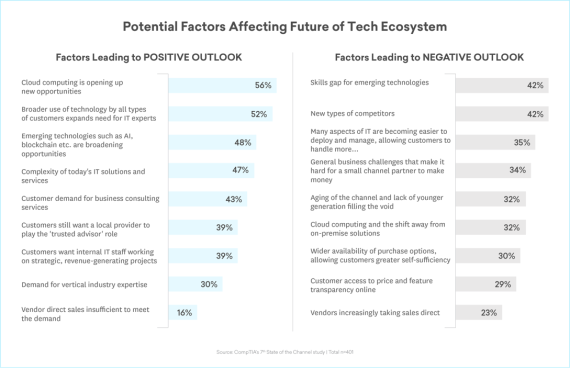Obstacles to MSP Success
This market growth is not without significant challenges, to MSPs and the client businesses they serve. The roiling changes taking place in IT, combined with growth in digital transformation efforts, affect all types of businesses. In addition, MSPs face challenges unique to their roles.
MSPs: Changing Roles and Definitions
It has even become challenging to define the term “MSP,” or for MSPs to decide on what mix of solutions to offer. The CompTIA 2018 State of the Channel report found “most channel firms, especially those coming from the more traditional ranks vs. newer entrants, remain hybrid in nature. They might identify as an MSP, but also conduct some hardware sales, integration services, cloud and SaaS work, and other activities.”
This may explain why “64% of firms [surveyed by CompTIA] expect their mix of offerings to change to new types in the next two years.” In comparison, “22% of firms expect no change in portfolio,” while “14% of firms do not yet know.”
The Future Is “Cloud-y” for MSPs
Whatever particular mix of solutions each MSP chooses to offer, all must contend with the transformative effects of cloud computing. The growth of cloud computing has been a major driver of digital transformation, for businesses that buy, use, or sell IT solutions.
An April 2018 Grand View Research study forecasts a compound annual growth rate (CAGR) for cloud managed services of 15.4 percent through 2025. This could mean a market for such services larger than $80 billion by that year.
Cloud computing makes a variety of resources available as pay-as-you-go, pay-as-you-grow services. It can replace capital expenses with more manageable and predictable operating expenses. It can support critical workloads and integrate with incumbent premises-based IT. And cloud services platforms are more secure than almost any other commercial IT estate.
These and other benefits mean that every MSP must develop a credible cloud support strategy, and back it up with high performance. That strategy must also clearly and credibly address the many technological, operational, and managerial challenges created by multi-client, multi-cloud, multi-service situations.
Beyond the Cloud: Optimism and Caution for MSPs
Despite its challenges, cloud computing was cited by more than half (56 percent) of the CompTIA survey respondents as the top reason for optimism about their future. However, it was also cited as a potentially negative factor by nearly one-third (32 percent) of those same respondents. The survey highlighted an interesting mix of additional potentially positive and negative effects on the future of MSPs. These are summarized in the graphic below.





